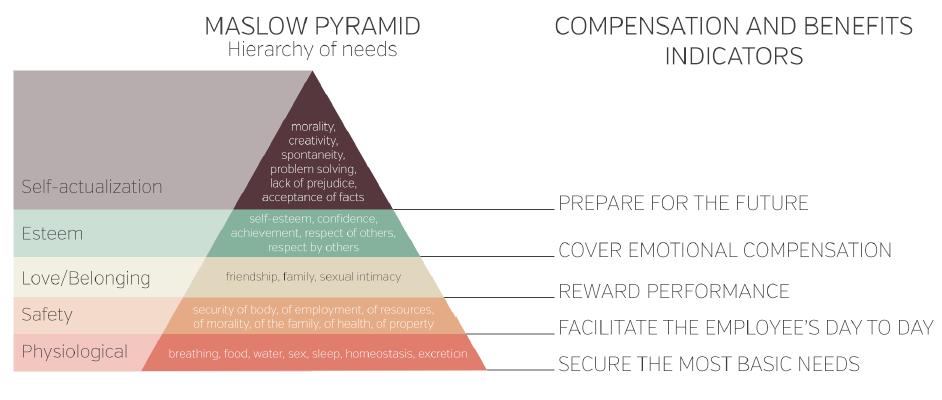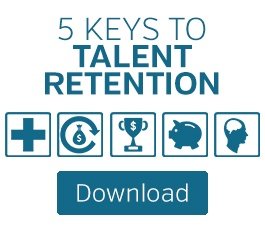The current climate and rapidly evolving organizations raise many challenges for businesses today. In the HR field, clearly one such challenge is the ability to retain talent.
In an increasingly competitive environment for attracting the best talent, companies develop real HR marketing strategies. According to the Bersin “Human Capital Trends” study for 2014, it will be very difficult to retain the most competent employees in global organizations. In the face of this challenge, organizations gather their wits to reinforce employee engagement and minimize the brain drain of high added value. In fact the same report— upon analyzing the situation at the human level across various organizations globally—has spotted that engagement is one of the keys to employee retention.
If we refer to Maslow’s pyramid to analyze the level of employee engagement, we can identify which aspects will develop engagement and we discover that the most basic needs are physiological and those of safety, followed by love/belonging, esteem and at the apex of the pyramid, self-actualization.
In this article, we will take a look at five different compensation and benefits indicators that will help us respond to the different employee needs as put forward by the pyramid, and this way improve motivation and job satisfaction levels, preventing talent brain drain. Examples will be given based on practical cases from multinational companies.
Five compensation and benefits indicators for improving employee retention:
-
Secure the most basic needs
For their employees, companies must represent institutions that take care of them and cover their basic needs. They must provide minimal benefits like health coverage for the employee and family members, or a life insurance—these are essential when configuring compensation policies to cover these basic needs without which companies risk a weakened sense of engagement among employees. This first point covers basic and physiological needs matching the first level of the Maslow pyramid.
Many companies in the English-speaking part of the world consider it crucial to, for example, offer benefits that give access to medical care for the employee and his family.
In multinational companies…
One of the main advantages of this is that multinationals are able to develop the same conditions for medical and health coverage for all their countries, creating an important impact through a basic benefit which is global and common to all company employees. When choosing a provider, it is vital to make sure that full coverage is guarranteed together with a fast and accessible service in the countries where the employee will work, especially if he is constantly travelling on the job.
-
Facilitate the employee’s day to day
Aside from basic benefits, a benefits policy for facilitating the employees’ day to day work has a great impact on how employees evaluate the organization; typically this raises their level of commitment. Agreements with other companies (telephone, transport, consumer goods, etc.) or institutions (education, health, leisure, real estate) give employees access to a number of advantages that improve their daily activity.
Another tool in this strategy is flexible benefits. This represents a significant plus for the employee as it allows him to design the format of their compensation based on their personal needs. However, this is something heavily regulated which differs considerably between countries and should be correctly addressed within a global compensation and benefits policy.
This second point involves satisfying economic needs and those for safety and wellbeing, just as Maslow describes in the second level of his pyramid.
In multinational companies…
This aspect offers a great opportunity at the global level for promoting and supporting international mobility. This kind of benefit may involve assistance for expats or any foreigner working outside his country of origin. This way the company can position as an entity facilitating internal mobility for their employees, offering them all the opportunities for their personal and professional development.
-
Reward performance
Linking high performance to a compensation or benefits indicator is another key to strengthening employee engagement to the organization.
In times of tight budgets, linking pay to performance criteria may be a good strategy. It also helps the employee to develop his skills and increase his value within the organization. The HR teams need to set clear and achievable goals to prevent employee demotivation, if levels are set too high.
In addition to associating compensation to performance, the rewards for outstanding achievements increase the individual’s sense of engagement. These can be set using direct compensation, an additional benefit or other direct incentives. Together with extra pays and rewards for high performance, new trends emerge in companies such as contest winners rewarded with travel trips, cars or other direct incentives.
Rewarding employee performance, apart from covering economic needs, facilitates the needs for self-esteem and thus, the third level according to Maslow’s pyramid.
In multinational companies….
Performance incentives and compensation opens doors to a variety of measures the company can undertake to boost inter-country work teams, creating for example, company-wide contests or projects for all subsidiaries and so increase internal competitiveness.
-
Nurture emotional compensation
Compensation budgets have been drastically reduced and salary revisions are controlled by new mechanisms. It is clear that the organization has to allocate a significant portion of its salary revision budget to items identified as priorities for retention. That is why “emotional salary” has now become essential, impacting employees strongly. Companies must consider this value when designing their compensation policies.
Indeed this phenomenon, which goes beyond the salary, can be defined as the feeling of recognition that an employee senses which also further meets the needs for safety, belonging, esteem and even self-actualization. It thus seems essential to establish emotional compensation in the organization, at least for items important for retention. This may be reinforced through linking salary revision campaigns to internal promotion policies and mobility, as well as to benefits plans.
Many companies don’t think twice about increasing meetings between employees and managers for discussing desires and needs, in order to safeguard emotional balance. Feedback (both employee to manager, and vice versa) is consequently of importance.
This fourth point creates a sense of social recognition as well as a feeling of importance, similar to the criteria Maslow defines at the fourth level of his pyramid.
In multinational companies…
It is crucial at this level to consider the employee’s professional and personal desires throughout his life in the company. The basis for ensuring an optimal emotional salary for the employee is the capacity to assure international internal mobility within the company. Today more than ever, the ability to offer horizontal and vertical talent opportunities at the global mobility level is the key to securing employee engagement.
-
Prepare for the future
At a higher level, setting the indicators that affect the future of the employee is a very interesting strategy and one of the most efficient steps for raising employee satisfaction and engagement.
First of all, the company can offer benefits which let the employee build assets for the future. Pension, retirement, and savings plans are typically the most used tools in that respect. Secondly, the organization may involve the employee in the long-term sustainability of the business and propose investing in company stock. This is the case of the stock option plans which signify a tax benefit for the employee. As for engagement, the organization achieves very strong ties with the stakeholder over time.
In this last point, the notion of human development and long term engagement emerge, which Maslow associated with the need for self-actualization in the apex of his pyramid.
Such benefits have become mandatory by law in some countries (for example, the law for “participation épargne et salariale” in France) and are on the rise in most global organizations.
In multinational companies…
A great opportunity for the organization at the global level would be the ability to apply best practices as far as possible across the different subsidiaries for all local employees to benefit from these conditions. This way, the company can create branding through long-term benefits management and thus cultivate a sense of belonging among employees, as well as convey competitive edge at the HR level to the market.
In this light one of the biggest challenges in HR within companies today is retaining employees who most contribute to achieving business objectives. This improves if the company manages to develop a strong sense of employee engagement.
In this regard, compensation and benefits policies are configured as an efficient weapon, as these meet the 5 conditions for success by Maslow: achieve emotional salary, reward performance, meet the needs for basic benefits, improve the employee’s day to day, and prepare for their future. These policies are just as applicable to multinational organizations, while taking into account the particularities of Global HR Management. It is worthwhile to make the most of global capabilities for developing policies that benefit all, such as international competitions, universal health care, development of international mobility and global searching for the best talent, or initiatives to deploy common best practices and more. In this case we can clearly see how international presence can play in our favor. However, compensation and benefits policies cannot ensure 100% complete employee satisfaction and engagement. To achieve this end, it will be very attractive to complement these with professional development and corporate social responsibility plans.
Do you want to have this article to your e-book, download it here!









